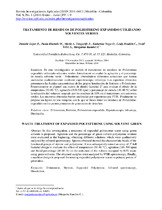| dc.contributor.author | López R., Daniela | |
| dc.contributor.author | Rhenals M., Paula | |
| dc.contributor.author | Tangarife Z., María A. | |
| dc.contributor.author | Vega O., Katherine | |
| dc.contributor.author | Rendón C., Leidy | |
| dc.contributor.author | Vélez S., Yesid | |
| dc.contributor.author | Ramírez C., Margarita | |
| dc.coverage.spatial | Seccional Medellín | spa |
| dc.date.accessioned | 2020-11-30T22:04:00Z | |
| dc.date.available | 2020-11-30T22:04:00Z | |
| dc.date.issued | 2014 | |
| dc.identifier.uri | http://hdl.handle.net/20.500.11912/6824 | |
| dc.description | 9 p. | spa |
| dc.description.abstract | En esta investigación se realizó el tratamiento de residuos de Poliestireno expandido utilizando solventes verdes. Inicialmente se evaluó la agitación y el porcentaje de mezcla solvente verde - Poliestireno, obteniéndose diferentes soluciones que fueron analizadas cualitativamente mediante espectroscopia infrarroja. Los espectros obtenidos presentaron las bandas características de los grupos funcionales de Estireno y Poliestireno. Posteriormente se planteó una matriz de diseño factorial 23 para evaluar el efecto de la temperatura (30-80 °C), agitación (310-500 rpm) y porcentaje de mezcla (40-80 %) sobre la reducción del volumen ocupado por los residuos de EPS en el tratamiento con solventes verdes. Las muestras obtenidas fueron analizadas por espectroscopia FTIR. Finalmente se propuso un layout de una máquina con la que se busca tratar los residuos de Poliestireno expandido en los puntos primarios de generación de desechos. | spa |
| dc.description.abstract | In this investigation, a treatment of expanded polystyrene waste using green solvents is proposed. Agitation and the percentage of green solvent-polystyrene mixture were evaluated at the beginning, obtaining different solutions which were qualitatively analyzed by infrared spectroscopy. Spectra obtained showed the characteristic bands of the functional groups of styrene and polystyrene. It was subsequently raised an array of 23 full factorial design to evaluate the effect of temperature (30-80 °C), agitation (310-500 rpm) and blend percentage (40-80 %) on the reduction of the volume occupied by EPS waste using green solvents. The obtained samples were analyzed by FTIR spectroscopy. Finally, a machine design is proposed for treating expanded polystyrene waste on primary points of generation. | spa |
| dc.format.mimetype | application/pdf | |
| dc.language.iso | spa | |
| dc.publisher | UPB | spa |
| dc.relation.ispartof | Revista Investigaciones Aplicadas | spa |
| dc.rights | Attribution-NonCommercial-NoDerivatives 4.0 International | * |
| dc.rights.uri | http://creativecommons.org/licenses/by-nc-nd/4.0/ | * |
| dc.subject | D-limoneno | spa |
| dc.subject | Estireno | spa |
| dc.subject | Poliestireno expandido | spa |
| dc.subject | Espectroscopia infrarroja | spa |
| dc.subject | Disolución | spa |
| dc.subject | D-limonene | spa |
| dc.subject | Styrene | spa |
| dc.subject | Expanded Polystyrene | spa |
| dc.subject | Infrared spectroscopy | spa |
| dc.subject | Dissolution | spa |
| dc.title | Tratamiento de residuos de poliestireno expandido utilizando solventes verdes | spa |
| dc.title.alternative | Waste treatment of expanded polystyrene using solvent green | spa |
| dc.type | article | spa |
| dc.rights.accessRights | openAccess | spa |
| dc.type.hasVersion | publishedVersion | spa |
| dc.description.sectional | Medellín | spa |
| dc.identifier.instname | instname:Universidad Pontificia Bolivariana | spa |
| dc.identifier.reponame | reponame:Repositorio Institucional de la Universidad Pontificia Bolivariana | spa |
| dc.identifier.repourl | repourl:https://repository.unab.edu.co/ | |


